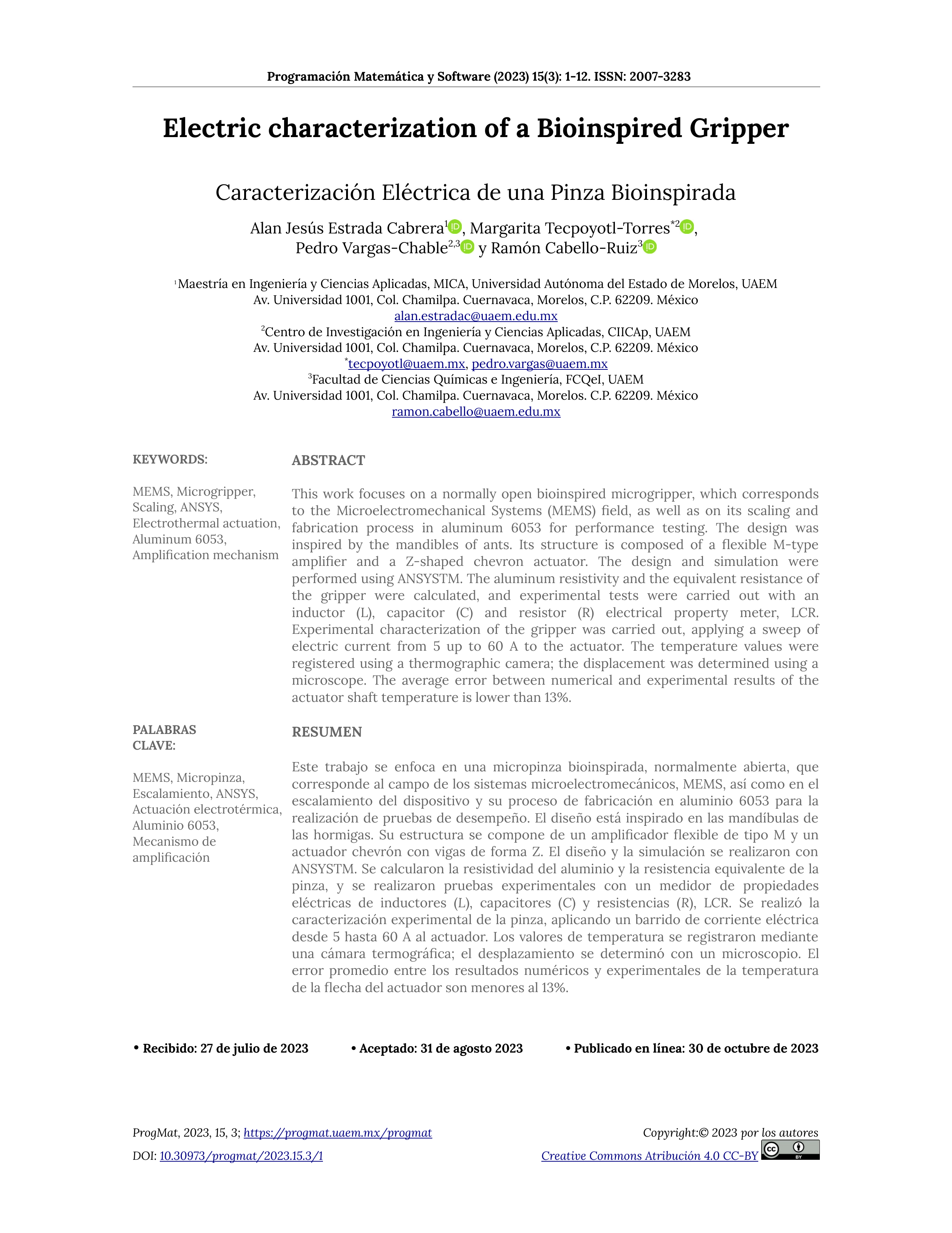Electric characterization of a Bioinspired Gripper
DOI:
https://doi.org/10.30973/progmat/2023.15.3/1Keywords:
MEMS, Microgripper, Scaling, ANSYS, Electrothermal actuation, Aluminium 6053, Amplification mechanismAbstract
This work focuses on a normally open bioinspired microgripper, which corresponds to the Microelectromechanical Systems (MEMS) field, as well as on its scaling and fabrication process in aluminum 6053 for performance testing. The design was inspired by the mandibles of ants. Its structure is composed of a flexible M-type amplifier and a Z-shaped chevron actuator. The design and simulation were performed using ANSYSTM. The aluminum resistivity and the equivalent resistance of the gripper were calculated, and experimental tests were carried out with an inductor (L), capacitor (C) and resistor (R) electrical property meter, LCR. Experimental characterization of the gripper was carried out, applying a sweep of electric current from 5 up to 60 A to the actuator. The temperature values were registered using a thermographic camera; the displacement was determined using a microscope. The average error between numerical and experimental results of the actuator shaft temperature is lower than 13%.
References
Chang, R. J., Lin, C. Y., Lin, P. S. Visual-Based Automation of Peg-in-Hole Microassembly Process. Journal of Manufacturing Science and Engineering. 2011, 133(4), doi: https://doi.org/10.1115/1.4004497.
Nocentini, S., Parmeggiani C., Martella, D., Wiersma, D. S. Optically Driven Soft Micro Robotics. Advanced Optical Materials. 2018, 6(14), doi: https://doi.org/10.1002/adom.201800207.
Lvu, Z., Qingsong, X. Recent design and development of piezoelectric-actuated compliant microgrippers: A review. Sensors and Actuators A: Physical. 2021, 331(1), doi: https://doi.org/10.1016/j.sna.2021.113002.
Franssila, S. Introduction to microfabrication. United Kingdom: John Wiley and Sons, 2010.
Pustan, M., Chiorean, R., Birleanu, C., Dudescu, C., Muller, R., Baracu, A., Voicu, R. Reliability design of thermally actuated MEMS switches based on V-shape beams. Microsyst Technol. 2017, 23(1), 3863-3871, doi: https://doi.org/10.1007/s00542-015-2789-8.
Biomimicry Institute. El proceso de diseño biomimético. Retrieved January 31, 2023, from https://toolbox.biomimicry.org/es/metodos/el-proceso-biomimetico.
Guan, C., Yong, Z. An electrothermal microactuator with Z-shaped beams. Journal of Micromechanics and Microengineering. 2010, 20(8), doi: https://doi.org/10.1088/0960-1317/20/8/085014.
Volstad, N. L., Boks, C. Biomimicry – a useful tool for the industrial designer?. Norwegian university of science and technology. In: Proc. of NordDesign 2008 Conf., Tallinn, Estonia, 2008, 275-284.
Yoon, C. K. Advances in biomimetic stimuli responsive soft grippers. Nano Convergence. 2019, 6(20) (2019), doi: https://doi.org/10.1186/s40580-019-0191-4.
Soma, A., Iamoni, S., Voicu, R., Muller, R., Al-Zandi, M. H., Wang, C. Design and experimental testing of an electro-thermal microgripper for cell manipulation. Microsystem Technologies. 2017, 24(2), 1053–1060, doi: https://doi.org/10.1007/s00542-017-3460-3.
Majidi Fard-Vatan, H., Hamedi, M. Design, analysis and fabrication of a novel hybrid electrothermal microgripper in microassembly cell. Microelectronic Engineering. 2020, 231(1), doi: https://doi.org/10.1016/j.mee.2020.111374
«Aluminum 6053-T6». s. f. Retrieved July 26, 2023, from https://www.matweb.com/search/DataSheet.aspx?MatGUID=779d41ab5fc7444b8b7d965a178a5d81.

Published
How to Cite
Issue
Section
License
Copyright (c) 2023 Alan Jesús Estrada Cabrera, Margarita Tecpoyotl-Torres, Pedro Vargas-Chable, Ramón Cabello-Ruiz

This work is licensed under a Creative Commons Attribution 4.0 International License.
Usted es libre de:
 |
Compartir — compartir y redistribuir el material publicado en cualquier medio o formato. |
 |
Adaptar — combinar, transformar y construir sobre el material para cualquier propósito, incluso comercialmente. |
Bajo las siguientes condiciones:
 |
Atribución — Debe otorgar el crédito correspondiente, proporcionar un enlace a la licencia e indicar si se realizaron cambios. Puede hacerlo de cualquier manera razonable, pero de ninguna manera que sugiera que el licenciador lo respalda a usted o a su uso. |
| Sin restricciones adicionales: no puede aplicar términos legales o medidas tecnológicas que restrinjan legalmente a otros a hacer cualquier cosa que permita la licencia. |







